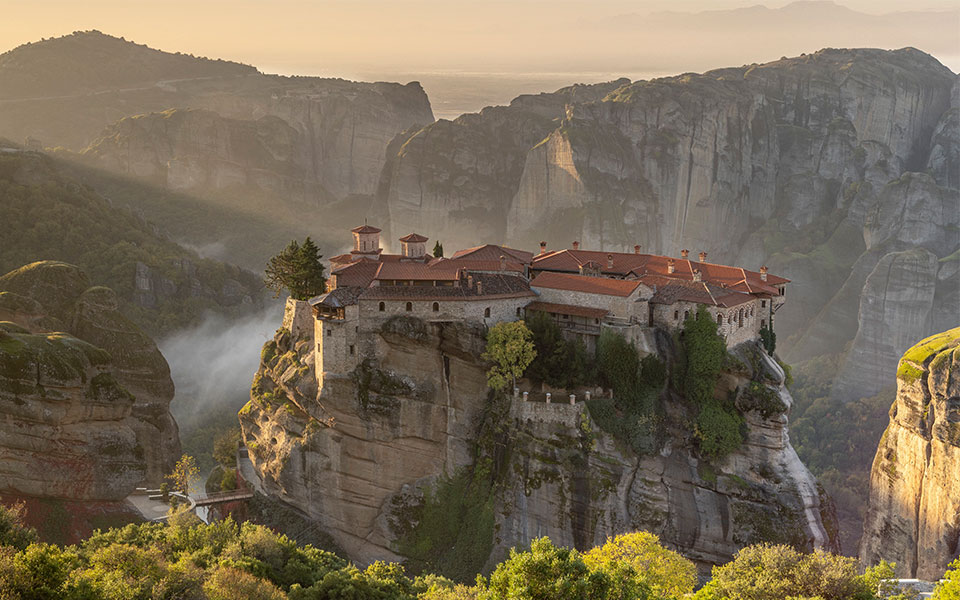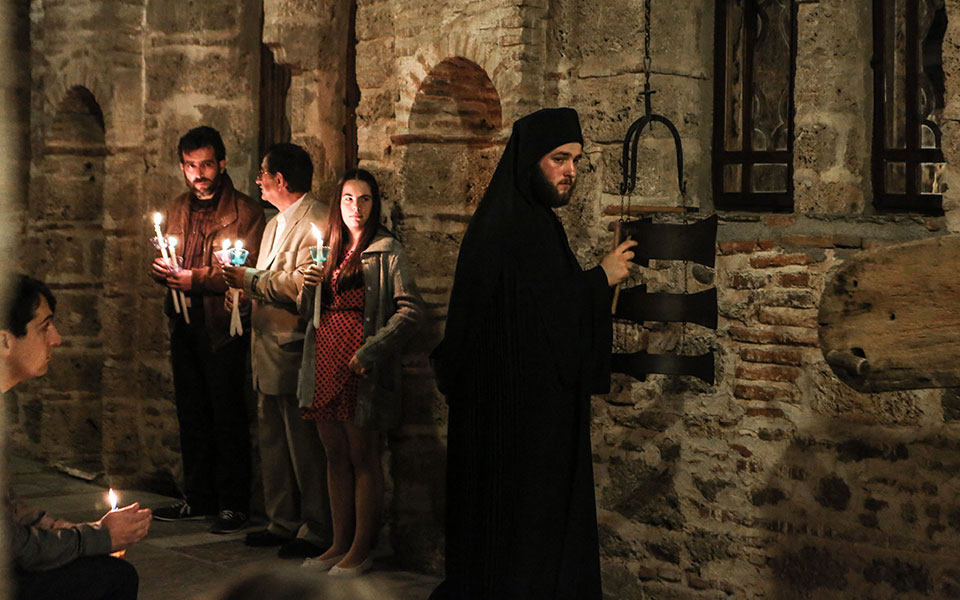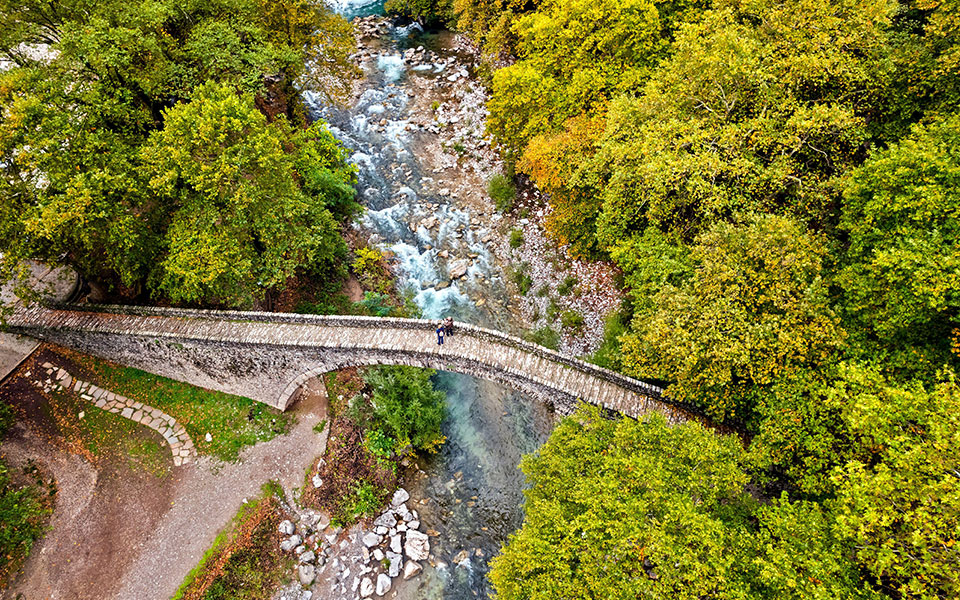A Cultural Culinary Getaway in Messolonghi
A brave history and uniquely beautiful...

Don’t miss the service of the Last Supper on Holy Thursday at the Monastery of Varlaam.
© AFP/Visualhellas.gr
In the distance to the south lies the city of Trikala and the Thessalian plain. To the northwest stands the imposing Pindos mountain range and, across from that, the mountain ridges of Agrafa. At Meteora, the second largest monastic complex in Greece, bested in importance only by Mount Athos, Easter combines a devout atmosphere with the eagerly anticipated arrival of spring. The immense black rocks that tower over Kalambaka stand in stark contrast to the lively kaleidoscope of colors that stretch across the landscape around them. Of the eight surviving monasteries, six are still functioning.
The Monastery of Varlaam offers what may be the most notable of the Easter services, that of the Last Supper and of the Holy Passion. Here, you’ll experience Christ’s anguished cry on the Cross, “My God, my God, why have You forsaken me?” – an impassioned moment for everyone in attendance.

The Holy Flame passes from worshiper to worshiper on the night before Easter Sunday.
© AFP/Visualhellas.gr
On Good Friday, don’t be surprised to see austerely modest Epitaphioi, or funerary processions of the bier of Christ, as the rituals here reflect the philosophy of monasticism. You can follow the funerary procession to the Monastery of Great Meteoron, the oldest and largest monastery of those that are still functioning. Alternatively, you can choose the Monastery of Aghios Stephanos, where the procession is shorter.
On Holy Saturday, services begin at 21:00; it’s worth sticking around after the Easter greetings of “Christos Anesti” (“Christ is Risen”) are exchanged, at which time most people leave, and the atmosphere becomes particularly subdued and devout.
On Easter Sunday, you can choose among the many tavernas in Kalambaka where lamb is roasted, in traditional style, on a spit. Celebrations continue on through to Easter Monday at Aghios Georgios Mantilas in Kastraki where local custom dictates that the young men and women of the village climb a sheer rock face to reach a cave. Here, they hang up colorful handkerchiefs and take down those placed there the year before, distributing the old cloths as lucky charms to those who gather to watch the event.

The impressive single-arch stone bridge over the Portaiko River near Pyli.
© Visualhellas.gr
Meteora is one of the most popular destinations in Greece for both religious and rock-climbing tourism. Included in UNESCO’s World Heritage List, Meteora is described by that international organization as “a region of almost inaccessible sandstone peaks… [where] monks settled on these ‘columns of the sky’ from the 11th century onwards.” The imposing landscape, with huge rock buttes topped by monasteries, attracts pilgrims from all around the country. The rock faces are crisscrossed by dozens of climbing routes offering adrenalin-fueled adventure.
Meteora is also ideal for hiking, particularly during spring when nature is in full bloom and the weather is mild. A particularly pleasant trail is the one which starts from City Hall Square in Kalambaka and passes through the old part of town, known as Sopotou, before making its way up to the Aghia Triada Monastery. The trail is largely paved with cobblestones, with a short dirt portion at the end. It runs uphill, but the incline is manageable, as the elevation gain is not great. The trail is 1,100m long, and you will need about 40 minutes to complete it.
If you’ve never seen the meadows of the small mountain village of Pertouli in the spring, this is your chance. Drive from Kalambaka to the village of Pyli, near Trikala (36 km). There, you can make a brief stop to admire the single-arch stone bridge that spans the Portaikos River and then make your way up to Pertouli (28 km) and Neraidochori.
Grand Meteora Hotel (Kastraki, Kalambaka, Tel. (+30) 24320.777.07) has modern double rooms starting from €90 including breakfast, as well as large suites with king size beds, living rooms and balconies with views of the rock formations of Meteora.
At Divani Meteora Hotel (Trikala-Ioannina National Road, Kalambaka, Tel. (+30) 24320.233.30), double rooms start from €171 including breakfast. Their superior and executive rooms have wooden floors and some have views of Meteora. The superior suite has a living room, a separate bedroom and a marble bathroom. The hotel offers many additional amenities; there are charging stations for electric cars; an indoor pool; and guided tours to Meteora and its monasteries. The hotel’s restaurant and bar serve a range of fine dishes and refreshing drinks.
Meteora Luxury Suites (Kalambaka, Tel. (+30) 697.899.9130) has accommodations for two persons starting from €70 not including breakfast; these include independent apartments, suites and villas that are located around the greater area of Kalambaka. From a classic, large apartment in the center of the city that can accommodate up to eight persons to a six-person house with a living room, dining room, and a balcony with a view of Meteora, Meteora Luxury Suites offers many different options suited for large groups and for families.
At Amalia Hotel (Theopetra, Kalambaka, Tel. (+30) 24320.722.16), double rooms start from €97 including breakfast. Located off the Trikala-Kalambaka National Road, the hotel offers elegantly furnished double rooms, as well as suites with living rooms and balconies with views of Meteora. For families, the hotel also offers interconnecting rooms.
At Heaven and Earth Premium Suites (Kastraki and Kalambaka, Tel. (+30) 697.230.6828), suites start from €125 not including breakfast. The company offers modern hospitality in both Kastraki and Kalambaka. Local traditional architecture, modern design and comfort are all on offer in the ten suites. You can book the Aggeia Suite in Kastraki with its red brick wall and whirlpool; the Rizes Suite in Kastraki with its double-sided fireplace; or the Selini Suite in Kalambaka with its unparalleled views of Meteora. All suites are furnished with 100% natural sleeping products and equipped with low-energy-consumption air conditioning units, while the fireplaces are energy-efficient and use briquettes.
Guesthouse Sotiriou-Petrino (Mesochori, Kastraki, Tel. (+30) 24320.781.05) offers double rooms starting at €90 including breakfast. Housed in a landmark building from 1845, the guesthouse has been restored with respect for its original architecture. The five rooms are traditional in design, and three of them also have a fireplace. Breakfast is served in the old cellar and includes handmade pies, hand-kneaded bread and homemade jams and marmalades.
A brave history and uniquely beautiful...
A steep and curvy drive high...
In the castle town of Monemvasia,...
With its lush riverbanks, fine museums,...